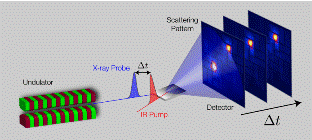Department of Physics and Astronomy: Publications and Other Research
Date of this Version
12-2013
Document Type
Article
Citation
NATURE PHYSICS, VOL 9, (DECEMBER 2013), pp. 790-794;
DOI: 10.1038/NPHYS2788
Abstract
The macroscopic characteristics of a material are determined by its elementary excitations, which dictate the response of the system to external stimuli. The spectrum of excitations is related to fluctuations in the density–density correlations and is typically measured through frequency-domain neutron1 or X-ray scattering. Time-domain measurements of these correlations could yield a more direct way to investigate the excitations of solids and their couplings both near to and far from equilibrium. Here we show that we can access large portions of the phonon dispersion of germanium by measuring the diffuse scattering from femtosecond X-ray free-electron laser pulses.A femtosecond optical laser pulse slightly quenches the vibrational frequencies, producing pairs of high-wavevector phonons with opposite momenta. These phonons manifest themselves as time-dependent coherences in the displacement correlations probed by the X-ray scattering. As the coherences are preferentially created in regions of strong electron–phonon coupling, the time-resolved approach is a natural spectroscopic tool for probing low-energy collective excitations in solids, and their microscopic interactions.
Supplementary information and 2 supplementary movies are attached below.
Configuration, Data analysis, Theory
Fuchs NP 2014 Fourier transform inelastic MOVIE 1.mp4 (1314 kB)
Movie #1
Fuchs NP 2014 Fourier transform inelastic MOVIE 2.mp4 (9680 kB)
Movie #2

